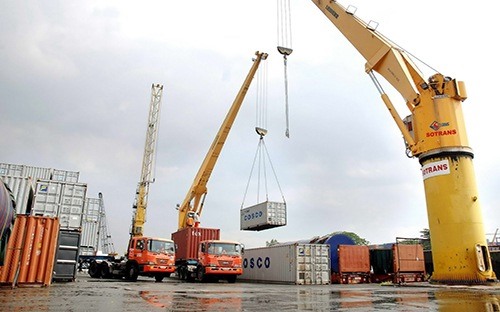Vietnam strategises to reach yearly export value target
HANOI – Vietnam will adopt multiple solutions to reach its target of US$200 billion in total export value for the year, a year-on-year increase of 13 per cent, officials said.
The target, which would mark a new record, if successful, is based on the country’s success with exports over the first eight months of this year.
Officials said the national export value would have high growth potential this year because Vietnam has advantages in exporting certain key products, such as farming products, seafood, telephone components and garments. The most important aspect is that local exporters must reform themselves and make use of good opportunities in export markets around the world.
For example, in terms of market structure, the United States has maintained its position as the largest export market for Vietnamese goods. However, according to the Ministry of Industry and Trade, local exporters’ greatest challenge in exporting their goods to this market is technical barriers, with strict standards for quality and food safety.
The barriers include regulations on inspections for pesticide residue in rice and regulations on testing for chemical and antibiotics residue in fisheries or catfish. These barriers have had a considerable impact on Vietnamese farming and seafood exports in recent years.
Therefore, the ministry said, for the long term, enterprises processing and producing goods for export should improve their competitiveness and the quality of their products to meet food-safety standards to maintain and expand their export market in the United States.
Meanwhile, ASEAN members and China are expected to continue being Vietnam’s key export markets. ASEAN has imported a large volume of Vietnamese goods, but Vietnam has faced difficulties in exporting its goods to this region due to the structural similarity of the exported goods.
The ministry said local enterprises would need to improve their production and processing capacity as well as their competitiveness in terms of quality and price to further penetrate the ASEAN market. In addition, they must take advantage of their geographic distance to reduce transportation costs and delivery time.
For other important export markets, such as Japan, South Korea and the EU, experts suggested that local exporters should ensure the quality of their goods, especially for the safety of consumers.
Minister of Industry and Trade Tran Tuan Anh also warned enterprises, departments of industry and trade and their affiliated units to strictly implement major tasks and solutions on rolling out the socio-economic development plan and state budget plan for this year, while the ministry executes the government’s resolutions on improving the investment environment, competition and enterprise development.
In addition, minister urged relevant authorities to address the tax and fee problems for businesses to help them cut costs, ensure market development and promote efficient competition, leading to growth in production. In particular, the state agencies should promote export market development and take advantage of free trade agreements to address technical barriers in global markets.
Exports over eight months
At present, Vietnam has exported its goods to some 200 countries and territories. Besides some high-potential markets such as the United States, the EU, Japan and South Korea, as well as China and the ASEAN, Vietnam has successfully entered new export markets in Africa and Latin America.
The ministry’s statistics show that Vietnam’s export value in August reached $18.2 billion, bringing the total national export value over the past eight months to $133.5 billion, up 15.7 per cent over the same period last year.
The domestic enterprises gained a year-on-year increase of 15.7 per cent in export value, reaching $37.8 billion, while foreign-invested enterprises achieved $95.7 billion in export value (including crude oil exports), 18.9 per cent higher than the same period last year.
Duong Duy Hung, director of the Ministry of Industry and Trade’s Planning Department, said for agricultural and seafood products, vegetables and fruits had the strongest growth in export value, reaching $2.35 billion, a year-on-year surge of 48 per cent. The growth was partly due to the efforts of expanding export markets for local vegetables and fruit across the world.
Vietnamese fruits have been marketed in many countries with strict quality requirements. Of these, the United States has permitted the entry of Vietnam’s dragon fruit, rambutan, longan and litchi; South Korea, Japan and New Zealand have licensed imports of Vietnamese dragon fruit and mango; and Australia has imported litchi, mango and dragon fruit.
According to the ministry’s Import and Export Department, during the first eight months of this year, the major export markets have seen strong growth in export value. The Asian market was one of the traditional markets but gained a strong increase of 24.5 per cent year-on-year and accounted for 50.5 per cent of total national export value.
Meanwhile, the export value of Vietnam’s goods to European markets saw a year-on-year growth of 12 per cent. Therefore, according to the Import and Export Department, local exporters should take advantage of free trade agreements signed between Vietnam and its partners to promote exports to the European market in the future. — VNS
Read more at http://vietnamnews.vn/economy/394298/vn-strategises-to-reach-yearly-export-value-target.html#dHPzFT7YodCTBuAH.99


 Thailand
Thailand




